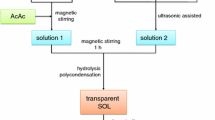Abstract
The hydrothermal degradation mechanism of tetragonal ZrO2previously proposed by the author was elaborated. In this mechanism, the annihilation of oxygen vacancies is a crucial step, and the grain boundaries play an important role in propagating the degradation. The degradation process of a 3 mol% Y2O3doped ZrO2pellet annealed in water vapor was monitored via impedance spectroscopy, the bulk and the grain boundary resistivity, and the grain boundary thickness were all found to increase with increasing annealing time, proving the annihilation of oxygen vacancies in the bulk and especially at the grain boundaries. The fracture surfaces of the annealed pellet were studied by SEM, only intergranular cracks were observed, indicating the propagation of the degradation along the grain boundaries. The mechanism predicts that the electrode resistance should increase when the electrodes are exposed to water vapor. Silver electrodes on a 8 mol% Y2O3doped ZrO2pellet were annealed in the mixture of oxygen and water vapor, the electrode resistance was found to increase with increasing annealing time. The prediction was thus proven.
Similar content being viewed by others
References
K. Kobayashi, H. Kuwajima and T. Masaki, Solid State Ionics 3/4(1981) 489.
T. Sato and M. Shimada, J.Amer.Ceram.Soc. 67(1984) C-212.
K. Tsukama and M. Shimada, J.Mater.Sci.Lett. 4(1985) 857.
T. Sato and M. Shimada, J.Amer.Ceram.Soc. 68(1985) 356.
Y. Murase and E. Kato, ibid. 66(1983) 196.
Y. Murase and E. Kato., Ber.Dtsch.Keram.Ges. 57(1980) 86.
T. Sato, S. Ohtaki, T. Endo and M. Schimada, J.Amer.Ceram.Soc. 68(1985) C-320.
J.-F. Li, R. Watanabe, B.-P. Zhang, K. Asami and K. H. Hashimoto, J.Am.Ceram.Soc. 79(1996) 3109.
T. T. LepistÖ, P. V. Lintula and T. A. MÄntylÄ, Ceram.Eng.Sci.Proc. 9(1988) 1517.
F. F. Lange, G. L. Dunlop and B. I. Davis, J.Amer. Ceram.Soc. 69(1986) 237.
T. Sato, S. Ohtashi and M. Shimada, J.Mater.Sci. 20(1985) 1466.
J.-F. Li and R. Watanabe, Mater.Transactions JIM 37(1996) 1171.
M. Yoshimura, T. Noma, K. Kawabata and S. Somiya, J.Mater.Sci.Lett. 6(1987) 465.
M. Yoshimura, Am.Ceram.Soc.Bull. 67(1988) 1950.
M. T. Hernandez, J. R. Jurado and P. Duran, J.Amer.Ceram.Soc. 74(1991) 1254.
T. Sato and M. Shimada, Am.Ceram.Soc.Bull. 64(1985) 1382.
T. Sato, T. Endo, M. Shimada, T. Mitsudome and N. Otabe, J.Mater.Sci. 26(1991) 1346.
M. Hirano, Br.Ceram.Trans.J. 91(1992) 139.
M. Yoshimura, T. Hiuga and S. Somiya, J.Amer.Ceram. Soc. 69(1986) 583.
X. Guo, Solid State Ionics 112(1998) 113.
X. Guo., J.Phys.Chem.Solids 60(1999) 539.
X. Guo., Phys.Stat.Sol.(a) 117(2000) 191.
X. Guo., Adv.Eng.Mater. 2(2000) 604.
J. Livage, K. Doi and C. Mazieres, J.Amer.Ceram.Soc. 51(1968) 349.
P. Kountouros and G. Petzow, in “Science and Technology of Zirconia V,” edited by S. P. S. Badwal, M. J. Bannister and R. H. J. Hannink (Technomic, Lancaster, Basel, 1993), p. 30.
K. D. Kreuer, Solid State Ionics 125(1999) 285.
X. Guo, Comput.Mater.Sci. 20(2001) 168.
J. Maier, Ber.Bunsenges.Phys.Chem. 90(1986) 26.
T. van Dijk and A. J. Burggraaf, Phys.Stat.Sol.(a) 63(1981) 229.
X. Guo and J. Maier, J.Electrochem.Soc. 148(2001) E121.
X. Guo, Phys.Stat.Sol.(a) 183(2001) 261.
X. Guo and R.-Z. Yuan, J.Mater.Sci. 30(1995) 923.
X. Guo., Solid State Ionics 80(1995) 159.
X. Guo, Solid State Ionics. 81(1995) 235.
X. Guo., J.Eur.Ceram.Soc. 16(1996) 575.
X. Guo., Solid State Ionics 96(1997) 247.
X. Guo., Solid State Ionics, 99(1997) 137.
S. P. S. Badwal and J. Drennan, J.Mater.Sci. 22(1987) 3231.
M. Kleitz, Solid State Ionics 3/4(1981) 513.
A. Mitterdorfer and L. J. Gauckler, ibid. 117(1999) 187.
Author information
Authors and Affiliations
Rights and permissions
About this article
Cite this article
Guo, X. Hydrothermal degradation mechanism of tetragonal Zirconia. Journal of Materials Science 36, 3737–3744 (2001). https://doi.org/10.1023/A:1017925800904
Issue Date:
DOI: https://doi.org/10.1023/A:1017925800904




